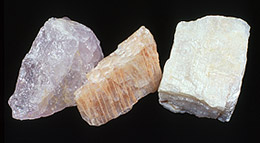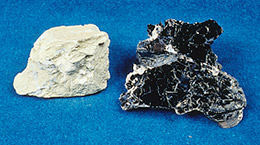Salinity Management Guide

Quartz (at left) and two kinds of feldspar: white striated plagioclase and pink potassium feldspar
Useful vocabulary
Mineral
A mineral is a naturally occurring solid material that has an "ordered," or regular, internal molecular structure. One example is quartz. Composed of an ordered network built from the two elements silicon and oxygen, quartz tends to form hexagonal, prism-like crystals that are relatively easy to recognize. Rocks are aggregates or assemblages of minerals.

Green clay mineral and biotite
Although several thousand different minerals are known, 60 percent of the rocks on Earth's continents consist, on average, of only three: the aforementioned quartz, plus two varieties of feldspar, another common silicon-oxygen mineral.
Clay minerals and micas, such as the dark-colored, platy mineral known as biotite, make up another 20% of Earth's continents. The remaining 20% of Earth's continental crust consists of calcite — the principal mineral in limestone — plus small quantities of metallic ore minerals, oxides, and relatively rare "exotic" minerals.
| « Previous page | Next page » |